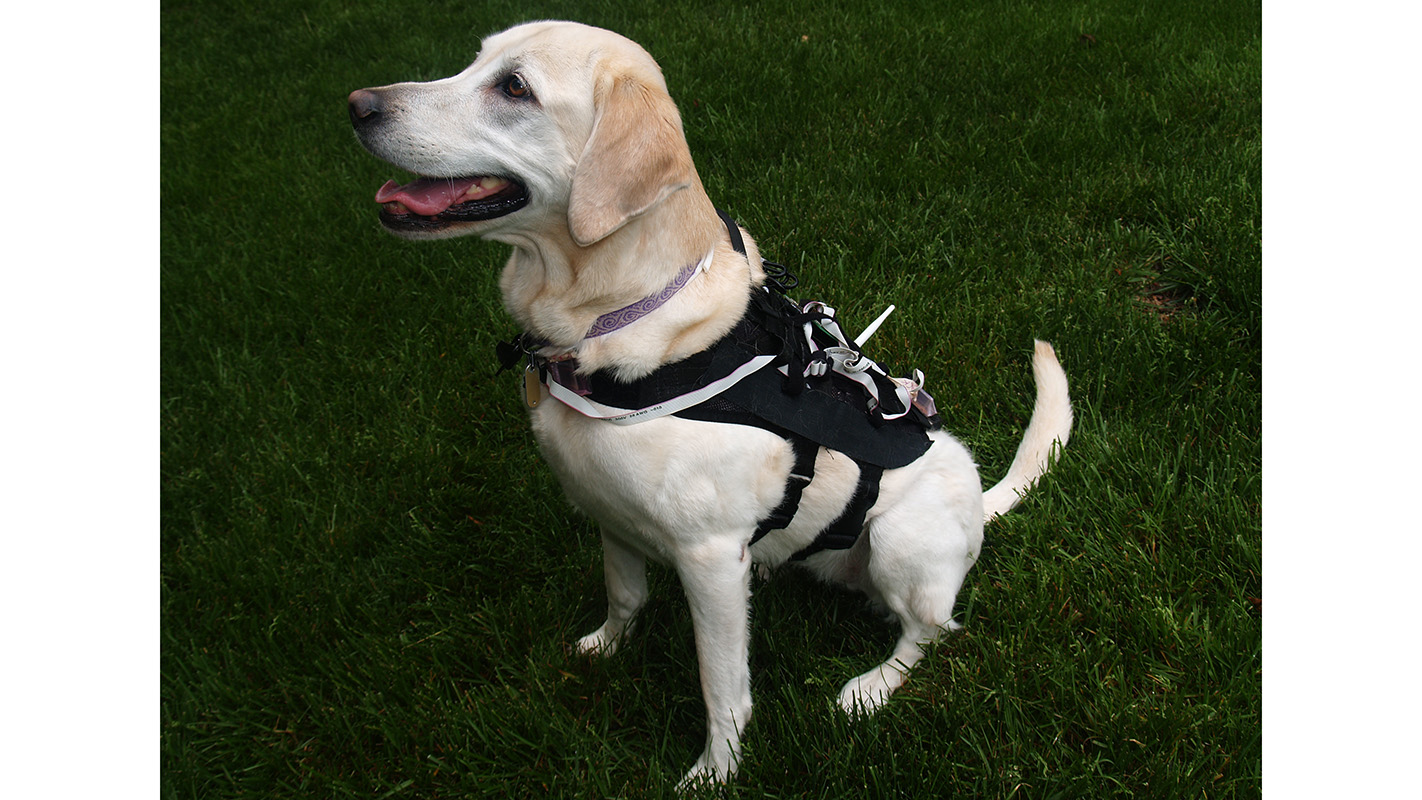For Immediate Release
North Carolina State University researchers have developed and used a customized suite of technologies that allows a computer to train a dog autonomously, with the computer effectively responding to the dog based on the dog’s body language.
“Our approach can be used to train dogs efficiently and effectively,” says David Roberts, an assistant professor of computer science at NC State and co-author of a paper on the work. “We use sensors in custom dog harnesses to monitor a dog’s posture, and the computer reinforces the correct behavior quickly and with near-perfect consistency.”
“Because the technology integrates fundamental principles of animal learning into a computational system, we are confident it can be applied to a wide range of canine behaviors,” says Alper Bozkurt, an assistant professor of electrical and computer engineering and co-author of the paper. “For example, it could be used to more quickly train service dogs. Ultimately, we think the technology will be used in conjunction with human-directed training.”
The dog harness fits comfortably onto the dog and is equipped with a variety of technologies that can monitor the dog’s posture and body language. Each harness also incorporates a computer the size of a deck of cards that transmits the sensor data wirelessly. The researchers published a paper about the harness’s potential applications in late 2014.
For the current study, the researchers wrote an algorithm that triggered a beeping sound and the release of dog treats from a nearby dispenser whenever the dog’s harness sensors detected that the dog went from standing to sitting.
The researchers had to ensure that the reinforcement was given shortly after the desired posture was exhibited, and also ensure that rewards were only given for the correct posture. This required a trade-off. If the algorithm ran long enough to ensure the correct posture with 100 percent certainty, the reinforcement was given too late to be effective for training purposes. But if the reinforcement was given immediately, there was a high rate of rewarding the wrong posture.
To address this, the researchers worked with 16 volunteers and their dogs to optimize the algorithm, finding the best possible combination of speed and accuracy. The researchers then compared the algorithm’s timing and accuracy to that of an expert human trainer.
The algorithm was highly accurate, rewarding the appropriate behavior 96 percent of the time. But the human trainer was better – with a 100 percent accuracy rate.
However, while the average response time was about the same for both algorithm and trainer, there was a lot of variation in the time of response from the trainer. The algorithm was incredibly consistent.
“That variation matters, because consistency is fundamentally important for all animal training,” Roberts says.
“This study was a proof of concept, and demonstrates that this approach works,” Bozkurt says. “Next steps include teaching dogs to perform specific behaviors on cue, and integrating computer-assisted training and human-directed training for use in various service dog applications.”
“In the long term, we’re interested in using this approach to animal-computer interaction to allow dogs to ‘use’ computers,” Roberts says. “For example, allowing an explosive detection dog to safely and clearly mark when it detects components of a bomb, or allowing diabetic alert dogs to use their physical posture and behaviors to call for help.”
The paper, “Balancing Noise Sensitivity, Response Latency, and Posture Accuracy for a Computer-Assisted Canine Posture Training System,” is published in a special issue of the International Journal of Human-Computer Studies, which focuses on animal-computer interaction. Co-lead authors of the paper are John Majikes and Rita Brugarolas, who are Ph.D. students at NC State. Co-authors include Dr. Barbara Sherman, a clinical professor of animal behavior at NC State; Michael Winters, Sean Mealin and Katherine Walker, Ph.D. students at NC State; Sherrie Yuschak, a clinical technician in NC State’s College of Veterinary Medicine; and Pu Yang, a former Ph.D. student at NC State who now works for IBM. This work was supported by the National Science Foundation under grant number 1329738.
-shipman-
Note to Editors: The study abstract follows.
“Balancing Noise Sensitivity, Response Latency, and Posture Accuracy for a Computer-Assisted Canine Posture Training System”
Authors: John Majikes, Rita Brugarolas, Michael Winters, Sherrie Yuschak, Sean Mealin, Katherine Walker, Pu Yang, Barbara Sherman, Alper Bozkurt, and David L. Roberts, North Carolina State University
Published: April 28, International Journal of Human-Computer Studies
DOI: 10.1016/j.ijhcs.2016.04.010
Abstract: This paper introduces a canine posture detection system comprised of wearable sensors and instrumented devices that detect canine postures such as sit, stand, or eat. The system consists of a customized harness outfitted with wearable Inertial Measurement Units (IMUs) and a base station for processing IMU data to classify canine posture. The latency and accuracy of feedback are extremely important when training animals. Research in operant conditioning, the science of behavior change, indicates that successful animal training requires consistent and accurate feedback on behavior. Properly designed computer systems excel at timeliness and accuracy, which are two characteristics most amateur trainers struggle with and professionals strive for. Therefore, we present initial steps in the development and validation of a computer-assisted training system designed to work outside of laboratory environments. The main contributions of this work are to explore the trade-off between low-latency responses to changes in time-series IMU data representative of posture changes while maintaining accuracy and timing similar to a professional trainer. Accordingly, in addition to describing our system, we present the results of three experiments to characterize the performance of the system at capturing sit postures of dogs and providing timely reinforcement. These trade-offs are illustrated through the comparison of two algorithms. The first is Random Forest classification and the second is an algorithm which uses a Variance-based Threshold for classification of postures. Results indicate that with proper parameter tuning, our system can successfully capture and reinforce postures to provide computer-assisted training of dogs.
- Categories:



